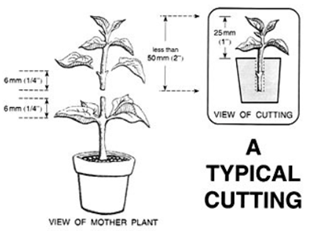
Preparation Of Planting Site
Preparing land for planting is one of the most important parts of cultivating abundance. Whether you're planting fruit trees, wildlife corridors, or an annual garden, prepping the soil in the first place is the best way to set yourself up for success over the long haul.
There are numerous methods that you can use for preparing land for planting that will help me make the living world around me come alive.
- One-Time Tilling
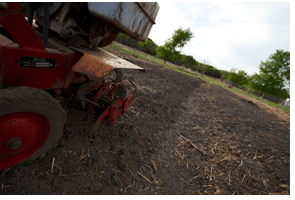
- Mulch Alone
- Sheet Mulching
- Double Digging
- Solarizing
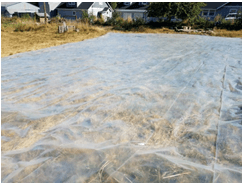
- Animals (focus on chickens and pigs)

Crop Establishment
Categories of planting materials
Types of Planting Materials
- Seeds (seasoning herbs, legumes, corn)
- Seedlings (most vegetable crops)
- Cuttings (cassava, potato, yam, ginger, dasheen, tannia, eddoes)
- Suckers (banana, plantain)
- Budded/ grafted plants (fruit trees)
Certain Factors need to be considered when you are choosing planting matter or seedlings from nurseries or plant shop.
Environmental Factors
- The surroundings should be free from overgrown bushes, generally clean, no waterlogged conditions
- Seedlings should be in conditions that are free from excess shade. If seedlings have too much shade they do not “harden off” and they have difficulties when they are transplanted.
Seedling Characteristics
The seedlings should:
- Be of the appropriate age (seedlings with 4-6 healthy green leaves)
- Be free from pests and diseases
- Have healthy white roots (good root development, with no balling of roots)
- Show vigorous, healthy growth
- Be of uniform appearance
- Have the proper Shoot to Root ratio (2:1)
Methods Of Planting Various Crops
- Broadcasting: Generally, the seeds are broadcast-sown and later planked. This method of sowing is easier and area coverage is quick. However, uniform population cannot be maintained since the seeds are not placed in uniform depth and germination may not be uniform. The skill of the labour is important to sow the seeds evenly covering the entire field. Broadcast-sowing is normally practiced under dryland condition. Seed requirement is generally high for broadcast sowing.
- Sowing behind the country plough: In this method, sowing is taken up behind the country plough operation. Seeds are dropped in the furrow opened during ploughing and subsequently covered while the next adjoining furrow is formed. Bold seeded crops like groundnut are sown by this method in drylands. It is important to take up sowing at the appropriate soil moisture so that the depth of sowing is uniformly maintained.
- Drill sowing or drilling: Drill sowing is one of the best methods that provides uniform plant population since seeds are uniformly dropped in the furrows. Animal drawn or power operated seed drills are used for this purposes; seed cum fertilizer drill can also be used. By this way, depth of sowing can be maintained; fertilizer can also be applied simultaneously. Pelleting of small sized seeds may reduce the risk of irregular dropping. Since sowing is taken up in lines, intercultural operations can be easily practiced. It is possible to take up sowing of intercrops also.
- Dibbling: In the method, a seed or few seeds are put in a hole and covered. Under irrigated condition, seeds are dibbled in lines or on the sides of the ridges maintaining optimum intra- row spacing, e.g. maize and cotton. Though this method is laborious and time consuming, it gives rapid and uniform germination and the requirement of seed is less than in broadcasting.
Methods of Plant Propagation
- Cutting
This is cutting the vegetative part of the plant (leaf, stem, and root) and then planting it again to regenerate the whole plant. The three types of cutting are named after the plant part being detached/cut:
- Stem cutting
- Leaf cutting
- Root cutting
- Division
This is a suitable technique for perennials (plants that live for more than two years). It involves dividing the plant by digging and moving it to an already prepared site. This helps the plant to rejuvenate and reduce water and nutrient competition.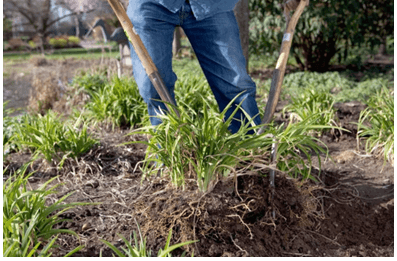
- Layering
In this technique, the attached and bent branch of the plant is covered with soil and allowed to root. After the emergence and development of roots that specific part of the plant is cut and allowed to grow as a new plant. This is called ‘layering’.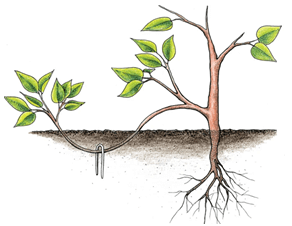
- Grafting
This involves cutting a twig of one plant and joining it with the stem of another plant in such a manner that they form a unit and function as one plant. It is a bit of a complex process but allows you to bring the desired character to your plant. However, be sure to sterilize your hands and tools to make sure you don’t transfer any infections during the process.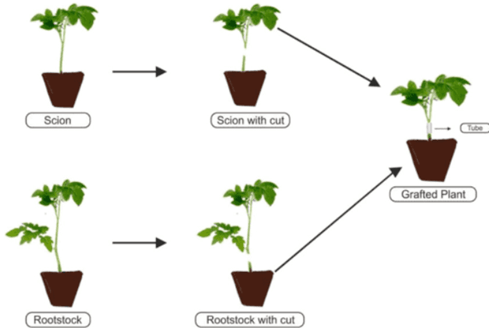
- Budding
In this method, a cut is made in the rootstock and a single bud with little or no wood is inserted into it in such a way that they unite and grow as a new plant.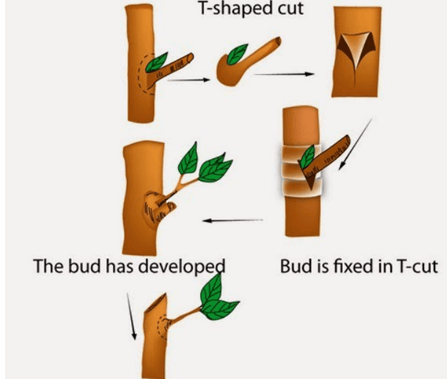
Time of planting depends on the following factors
- Soil and weather conditions
- The kind of crop to be planted.
- The time the produce is desired.

Crop Management
- Adoption of best crop management practices improves crop productivity and can contribute to greater yields with improved quality.
- Crop management is the set of agricultural practices performed to improve the growth, development and yield of crops.
- It begins with a seedbed preparation, sowing of seeds and crop maintenance; and ends with crop harvest, storage and marketing.
- The timing and sequence of agricultural practices depend upon several factors, such as winter or spring crops; harvested products such as grain, hay and silage; sowing methods-broadcast and row-crops; and, plants age, soil, climate and weather conditions.
Physical Methods Of Weeding
Manual control
Manual control is the use of the hands or handheld tools to deal with. An advantage of manual control is that it minimizes soil disturbance, and decreases the likelihood of erosion and seed germination.
Hand pulling
Hand pulling aims to remove the entire plant, including its roots, from the soil. This method is useful for small-scale infestations. It is best to hand-pull weeds after rain, when soil is moist. Sturdy gloves should be worn to avoid prickles, blisters or sap burns to the skin. It is not appropriate for all weed species, such as those with underground bulbs.
Hand tools such as broad knives and trowels can be used to remove underground parts of weeds (such as bulbs) that may reshoot. In some cases it is necessary to dig out the crown of the plant. This requires the growing part of the plant to be cut beneath the ground using a knife.
Grubbing or chipping
This method requires weeds to be dug out using a mattock or chip hoe. Depending on the plant, it may be important to expose the root system, and remove the crown.
In some cases, the mattock or chip hoe is used to cut the stem of the plant below the ground. This method is useful when the ground is hard. Gloves should be worn to avoid blisters.
Mechanical control
Mechanical control is the use of powered tools and machinery to manage weeds and is best suited to larger infestations. Care should be taken to minimise soil disturbance.
Slashing, mowing, dozing, pushing and felling
At times, controlling weeds using mechanical methods is preferred. However, care should be taken when machinery is used in the process.
Disturbing the soil with mechanical control can:
- increase the likelihood of seed germination
- damage native vegetation.
Bulldozers and chainsaws can be used on woody and tree weeds where they are pushed or felled and finally snigged (dragged away). These methods are only suitable in certain situations, as they create high levels of soil and vegetation disturbance. Also, shoots and seedlings require follow-up attention.
Grading or scalping the top layer of soil is an effective method of removing a seedbank. As this method greatly disturbs the soil, it is best suited for areas that are to undergo complete rehabilitation.
Earth Up
Earthing up refers to the act of heaping soil around the root zone of the potato plant. It is one of the primary production practices that must be done to increase the potato yield.
Advantages of earthing up
- improves tuber formation/expansion/roots/pods formation
- Improves drainage around the crop
- Conserves water/soil
- Facilitates harvesting of tuber crops
- Root protection
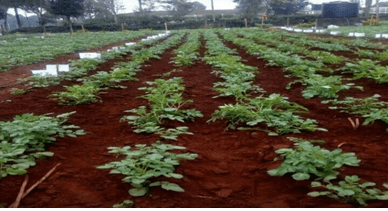
Managing Plant Spaces
Thinning
When the young seedlings are too close to each other, they do not grow well. They do not find enough nourishment in the soil and their leaves do not have enough room to develop.
Leave only the strongest plants and remove the others. This is called thinning.
When you take out the seedlings that are small, diseased or misshapen, be very careful not to damage the seedlings which remain in the beds.
At the end, pack down the earth around the base of the plants and water them.
Staking
Vegetables with long and weak stems, for example beans and tomatoes, need stakes.
A stake is a stick firmly embedded in the earth. It is best to use hard wood, which does not rot.
Pruning
Certain vegetables, like tomatoes, beans, eggplant, need pruning.
Nip off surplus buds. Then there will be more fruits and they will be bigger.
Gapping
When the seeds fail to germinate, empty spaces are seen within the rows. This if left unfilled can make the farmer incur losses as a result of low yields. The filling up of these spaces or the replacement of ungerminated seeds is called gapping.
Advantages of thinning and gapping
Both thinning and gap filling ensures ideal plant population and optimum utilization of sunlight, space, nutrients, moisture and other inputs which ultimately increases yield.
Crop Hardening
- Hardening, or "hardening off," is the process of allowing a plant to transition from a protected indoor or greenhouse environment to the harsh outdoor conditions of fluctuating spring temperatures, wind, and full sun exposure.
- A gradual introduction of these outdoor stresses will cause the plant to accumulate carbohydrates, to trigger more root development, to reduce the amount of freeze-prone water in the plant, and to actually thicken its cell walls. Plant growth will change from soft and supple to much firmer and harder.
Hardening Timetable
- Start the process of moving plants outdoors about two weeks before the weather will be favorable enough for the particular plant to live outdoors.
- Check seed package instructions or inquire where you purchase seedlings as to when the plant can tolerate outdoor conditions. (Keep in mind that air temperature is often warmer than soil temperature.)
- This Vegetable Planting and Transplanting Guide provides guidance for when some popular crops can be planted outdoors.
Hardening Process
- When temperatures are at least 45-50ᵒ, move plants outdoors to a shady, protected spot.
- Initially place in the shaded, sheltered location for two to three hours.
- Gradually increase the amount of sunlight the plants receive over the two-week period. The last day or two, the plants can spend 24 hours outside.
- Reduce the amount of water plants receive, but do not allow them to wilt.
- Avoid placing seedlings outdoors on windy days.
- Cold frames are excellent places to harden plants, but another spot that provides protection, such as a porch, will work.
- Pay attention to the weather forecast; if temperatures will fall below 45ᵒ, be prepared to bring the plants inside.
Keep in mind that the overall goal of hardening is to slow the growth of the plants to allow them to adjust to a change in conditions. After proper hardening, even warmth-loving vegetables, such as tomatoes, can withstand an unexpected dip in spring temperatures.
Importance of crop management practices
Learners to work on them.
Download Crop Production - Grade 7 Agriculture Revision Notes.
Tap Here to Download for 30/-
Get on WhatsApp for 30/-
Why download?
- ✔ To read offline at any time.
- ✔ To Print at your convenience
- ✔ Share Easily with Friends / Students

